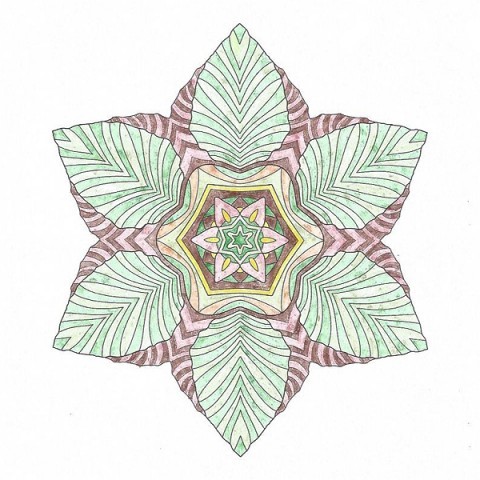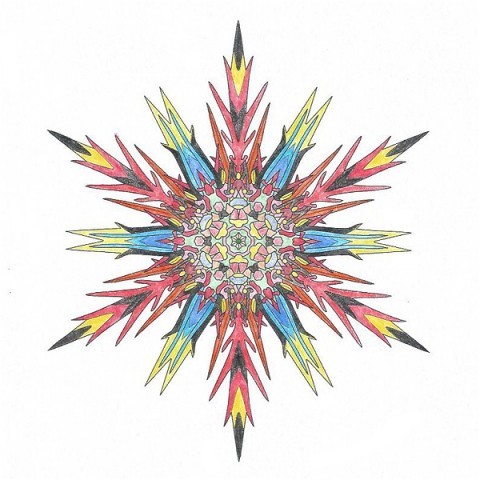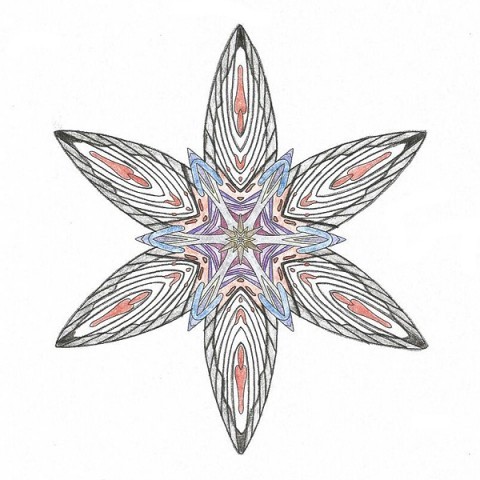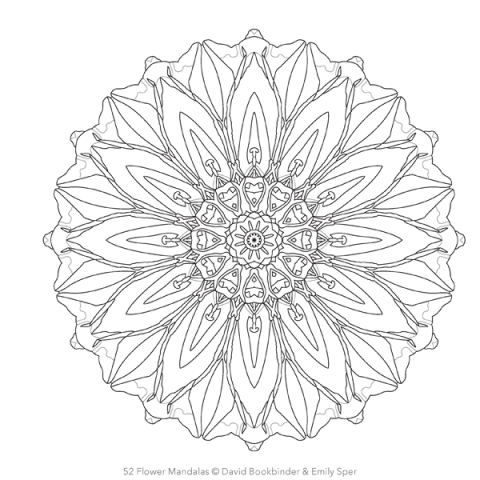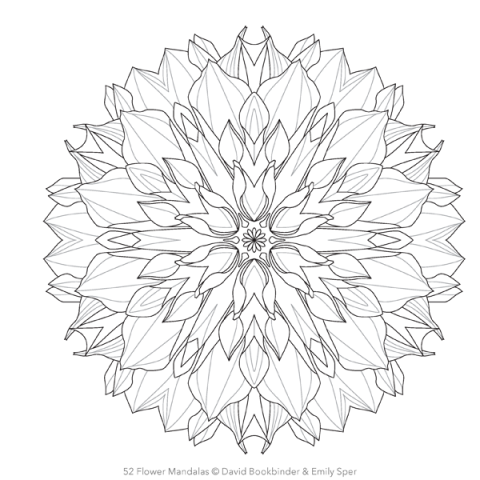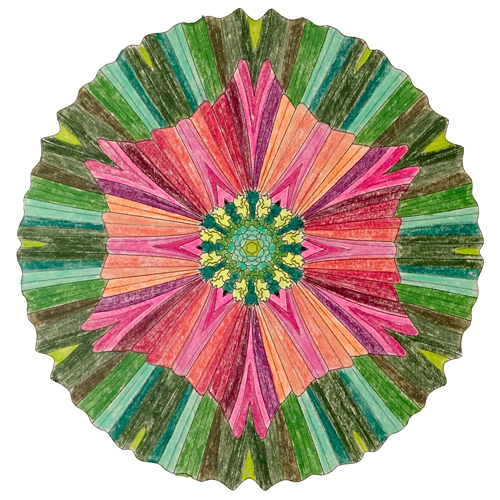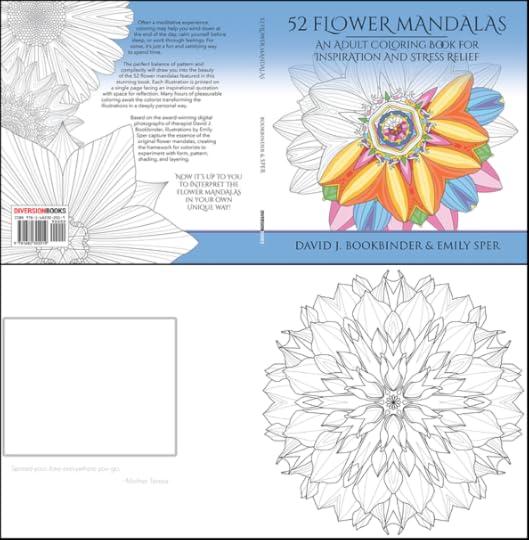David J. Bookbinder's Blog, page 11
December 2, 2015
Raffles, reviews, and samples! Oh my!
Share 52 Flower Mandalas on Facebook and Share 52 Flower Mandalas on Twitter
Breaking news! I’ve been finding out more from clients and colorists about coloring and it’s meditative qualities and will write another post on that soon, but some time-sensitive events are happening with 52 Flower Mandalas. Before I get to those events, though, here are two more completed illustrations from colorist C.G. Lynee, which she entitled “Arbor” and “Naos”:
And now, the news. First, the coloring book is live on Amazon, Barnes and Noble, and other online booksellers. Those who preordered should be getting your books within the next day or two. NOTE: It would be very helpful if you wrote a brief review on Amazon.com, Barnes and Noble, Goodreads.com (or even better, post the review in multiple places). We think this is a uniquely interesting book and hope you will, too.
And, we have created raffles for several copies on Goodreads.com and Rafflecopter.com. These will be available for the next few days. Enter now to win a copy of 52 Flower Mandalas.
Some links:
Create a review or buy the book on Amazon.com: http://www.amazon.com/52-Flower-Mandalas-Coloring-Inspiration/dp/1682302016/ref=asap_bc?ie=UTF8
Create a review or enter the giveaway on Goodreads: https://www.goodreads.com/giveaway/show/164003-52-flower-mandalas-an-adult-coloring-book-for-inspiration-and-stress-re
Enter the Rafflecopter giveaway: https://www.rafflecopter.com/rafl/display/a513935552/
Also:
Our Diversion Books page: http://diversionbooks.com/ebooks/52-flower-mandalas-adult-coloring-book-inspiration-and-stress-relief
Download a full-resolution sampler: http://www.davidbookbinder.com/books/wp-content/uploads/sampler_52FlowerMandalas_pages.pdf
And last, but very far from least, here are two more completed illustrations by C.G. Lynee, “Chrysalis” and “Titanides.” You can all view the completed drawings colorists have sent me so far, or post your own, on the Colorist Gallery page: http://www.davidbookbinder.com/books/gallery
Thanks!
– David
November 23, 2015
Can I pick your brains?
Share 52 Flower Mandalas with your friends!
Art Bars, Coloring Parties, other audiences
Now that our coloring book 52 Flower Mandalas is completed, I’d like to find more ways to get it out into the world. Marketing and promotion, alas, have never been my strengths, so I’d appreciate some advice and some help.
A friend suggested that because coloring is a relaxing, meditative, but also a creative activity, 52 Flower Mandalas would be an asset to HR departments (who could use it in workshops), schools (where it could be used as a relaxation technique with teachers and older students), and as an alternative to “art bars” and “painting nights” at various venues. All of this made sense, but how to get from idea to actuality is something of a mystery to me.
So, I am asking you for suggestions on how to approach these venues, for specific places I might contact, and for places you would be willing to contact that could be interested in using this book in workshops or other coloring gatherings.
Thanks for thinking about this!
More anon,
David
Buy 52 Flower Mandalas: An Adult Coloring Book from Amazon.com
Subscribe to the Flower Mandalas mailing list and get a free digital sampler of the 52 Flower Mandalas coloring book
Visit the 52 Flower Mandalas coloring book website, where you can upload your creations and check out what other colorists have done
Buy Flower Mandala prints: Buy prints
Request the 15 Flower Mandalas screensaver: Fifteen Flower Mandalas
Discussion: Facebook Flower Mandalas page
November 18, 2015
On Coloring
Share 52 Flower Mandalas: An Adult Coloring Book for Inspiration and Stress Relief with your friends!
I stumbled into coloring. Shortly after I completed a Kickstarter campaign for my book Fifty-Two Flower Mandalas: A Mediation, a friend suggested that I convert the images to illustrations and create a coloring book — not for children, but for adults. Until then, I had never even heard of coloring books for adults. Now, months later, I see that it’s a whole world. One of the colorists who advised me on coloring books during the creation of 52 Flower Mandalas: An Adult Coloring Book for Inspiration and Stress Relief helped unravel the mystery for me. She wrote:
“Untitled” by Sarah Blue
“Why color at all? Because it’s PLAY. Because creativity renews the whole person and sparks other ideas not related to the coloring — your mind has time to go into an almost meditative state. Because it’s fun. Most kids love to color and hate giving it up. Go back to your inner kid and have fun. You might want to make a flower as realistic as possible, or you might choose a total fantasy version — say in 60’s tie dye colors. You might pay attention to the mandala form of each design — how it can be used for meditation and focus. Or use coloring as a kind of therapy, because personal expression is therapeutic, helps stop rumination, relaxes. But mostly, coloring is about play and the love of color.
“Maybe one has to be a bit of a rebel to color as an adult — to take on that child-oriented activity again. But most of us never did really want to give it up. Something magic happens when the design is colored to one’s satisfaction. Here’s something no one else in the world did or could do. I am an individual. I have a distinct view of the world and I express it here. So, relax and go with your gut choices. There’s no particular way it is supposed to turn out. Just pick the colors that appeal to you for that design and use them to create your individual vision.”
Since this project begain, I’ve worked with a variety of people who color. Some do it simply to play. Some to relax. Some to enter a different mental/emotional/spiritual space, and others as a kind of self-therapy. I’ve started using coloring with some of my anxious clients. One told me she began in an angry mood and saw, in the design, what looked to her like a bull. She worked out her anger coloring the “bulls” and then saw another pattern that reminded her of a heart. Coloring those hearts, her own heart opened.
Working with these ilustrations has opened my own eyes, and my heart, to another way of seeing creativity. Perhaps it will do the same for you.
David
Buy 52 Flower Mandalas: An Adult Coloring Book from Amazon.com
Subscribe to the Flower Mandalas mailing list and get a free digital sampler of the 52 Flower Mandalas coloring book
Visit the 52 Flower Mandalas coloring book website, where you can upload your creations and check out what other colorists have done
Buy Flower Mandala prints: Buy prints
Request the 15 Flower Mandalas screensaver: Fifteen Flower Mandalas
Discussion: Facebook Flower Mandalas page
November 11, 2015
“Untitled,” a colorist creation by S. Everett
Share 52 Flower Mandalas: An Adult Coloring Book for Inspiration and Stress Relief with your friends!
“Untitled,” a colorist creation by S. Everett, one of the colorists I’ve been working with on “52 Flower Mandalas.” See http://davidbookbinder/books/gallery for the latest colorist creations.
November 10, 2015
“Gateway,” a colorist creation by C.G. Lynee
Share 52 Flower Mandalas: An Adult Coloring Book for Inspiration and Stress Relief with your friends!
“Gateway,” a colorist creation by C.G. Lynee, one of the colorists I’ve been working with on “52 Flower Mandalas.” See http://davidbookbinder/books/gallery for the latest colorist creations.
November 8, 2015
Something new: “52 Flower Mandalas” coloring book for adults
Share 52 Flower Mandalas: An Adult Coloring Book for Inspiration and Stress Relief with your friends!
Child psychologists observe that children are most creative when they’re at play. The same principle also applies to most adults.
With 52 Flower Mandalas: An Adult Coloring Book for Inspiration and Stress Relief, you can return to your inner child … play. Coloring relaxes and renews, sparks ideas, relieves stress, helps work through emotions — and it’s fun!
The stunning Flower Mandala illustrations in this just-released coloring book were created by artist Emily Sper from 52 of my Flower Mandala images. In her designs, Emily has captured the essence of the Flower Mandalas and translated them into a family of illustrations that invite you to create your own unique works of art, experimenting with form, pattern, shading, and layering in a deeply personal way.
52 Flower Mandalas: An Adult Coloring Book for Inspiration and Stress Relief was a collaboration. Now, we invite you to collaborate with us, adding to these illustrations your own unique interpretations.
Preorder before December 1, 2015 for a special bonus collection of downloadable illustrations! (More soon on how to claim your bonus.)
Buy 52 Flower Mandalas: An Adult Coloring Book from Amazon.com
Subscribe to the Flower Mandalas mailing list and get a free digital sampler of the 52 Flower Mandalas coloring book
Visit the 52 Flower Mandalas coloring book website, where you can upload your creations and check out what other colorists have done
Buy Flower Mandala prints: Buy prints
Request the 15 Flower Mandalas screensaver: Fifteen Flower Mandalas
Discussion: Facebook Flower Mandalas page
October 1, 2015
Something new…
Just a note to let you know that something new is in the pipeline. It’s the culmination of a collaboration with illustrator and book designer Emily Sper (http://www.emilysper.com/hactiv.html).
More details, and an invitation to participate in the process, coming soon. Watch this space!
May 18, 2015
Agent!
I’m happy to announce that Fifty-Two Flower Mandalas is now represented by Stephany Evans, president of Fine Print Literary Management in New York City.
More anon,
David
Buy Flower Mandala prints: Buy prints
Discussion: Facebook Flower Mandalas page
Flower Mandalas blog on Beliefnet.com: Flower Mandalas blog
Subscribe to the Flower Mandalas mailing list
Request the 15 Flower Mandalas screensaver: Fifteen Flower Mandalas
February 6, 2014
Fifty-Two Flower Mandalas: “Will: Break on through”
NOTE: This is the first draft of the “Will” essay in my forthcoming book, Fifty-Two Flower Mandalas. Responses and comments welcome, no matter how brief.
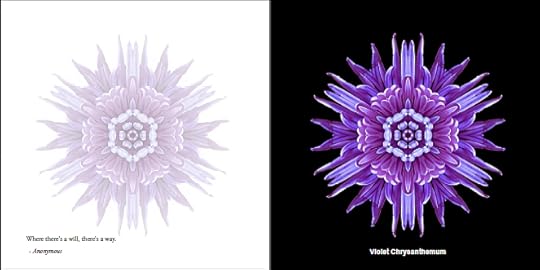
Will: Break on through
Copyright 2014 David J. Bookbinder
There are many ways psychotherapists can help people. We can provide validation, emotional support, help formulate goals, encourage, motivate, identify dysfunctional patterns, devise strategies for overcoming them, and sometimes even inspire. But often, to fully surmount difficulties, there is a decisive moment when will comes into play.
Will is what enables us to get up and do it again, raises the apparently defeated fighter from the mat, enables the runner to move out from behind when at the brink of total exhaustion. Will is what keeps us going when everything in us says we can’t. Will is the difference between the triumphant and the failed hero, not only in myth also in our own personal struggles.
Will is the key to breaking through what one of my mentors, psychologist Jim Grant, called the “Spell ceiling.” Our collections of past injuries, and the mistaken beliefs and patterns we have created to protect ourselves from them, can be regarded as a trance-like Spell. This Spell subconsciously controls much of what we think, feel, and do. Until we awaken from it, it commands us to repeat our patterns. When we increase awareness and act in ways that defy our Spells, they weaken and we get stronger.
The Spell ceiling occurs just as the Spell is about to yield. At that point, the Spell – which doesn’t know we don’t need its protection anymore – puffs itself up and, like the Wizard at the end of The Wizard of Oz, tries to persuade us that there’s yet another job for us to undertake. Though we have killed our Wicked Witches, the Wizard tries to scare us into going on another mission anyway because that’s all he knows how to do.
But by then we have changed. Just as the characters in the movie have worked through their illusions – the “heartless” Tin Man has shown compassion, the “brainless” Scarecrow has demonstrated his intelligence, the “cowardly” Lion has led the charge, and “homeless” Dorothy now wants nothing more than to return to Auntie Em and Kansas – we have reached the threshold of our true selves without realizing it.
It’s not difficult to spot the Spell ceiling if you know it’s there. Old patterns reemerge. In therapy sessions, I hear clients suddenly using words like “overwhelmed,” “lazy,” and “just”: “I just couldn’t make myself do it. I was overwhelmed. Maybe I’m just lazy.” People who rarely have problems focusing space out in sessions. Those who have been on time for months forget their appointments. “It feels like I’m going backwards,” some of them say.
At this critical moment, will must come into play. If we succumb to the Spell now, we lose ground and it resumes its role of puppeteer. If, instead, we muster up our will to resist returning to old patterns, the curtain is soon pulled aside and the Wizard revealed to be merely an old man shouting desperately into a megaphone to bolster the illusion that he still has power. When the hold of the Spell is broken, we are free to redirect the energy we have been supplying to it, fueling our own growth.
We have broken through the Spell ceiling, but unlike the Wizard in the film, the Spell has not thrown in the towel. To continue to stay ahead of it, we need to continue to do what got us to the other side. Will is again the tool we need, coupled with awareness.
In 12-step recovery programs, the phrase “fake it till you make it” expresses the idea of using will to assume new, more self-actualizing behaviors and attitudes. By willing ourselves to act as if we are already living a sober life, we live the sober life, and its benefits become clear. Similarly, the socially anxious person who acts as if he or she is not anxious often becomes calmer and more outgoing in social situations; the depressed person who acts as if he or she is not depressed behaves in ways that can dispel depression; and so on. Faking it till you make it applies even on the bodily level. Willing ourselves to smile even when it seems as if everything inside wants to frown creates the same physiological response as spontaneous smiling, and that physiological response can improve our mood and our outlook. (Try it now!)
A tool I use with therapy clients to counteract the Spell is the Personal Craziness Index (PCI). Borrowed from the book A Gentle Path Through the Twelve Steps, by Patrick J. Carnes, the PCI provides a way to catalog, in each of ten major life areas, three indicators that remind us how we act when we are Spell-free. Then we track the most significant seven every day. If we are seven-out-of-seven, all is well. If we notice we are slipping back into Spell-influenced behaviors, chances are good our Spell is setting us up for another assault.
The preventive is built into the PCI. For instance, suppose that in the “Health” category we wrote that when we are doing well, we go to the gym three times a week, cook our own meals, and sleep at least seven hours per night. When we notice we are skipping the gym, or picking up junk food, or skimping on sleep, we become aware we are drifting out of the behaviors that helped us break our Spells. At this point, we’ve given up only a little ground, and getting back on track is easy: we will ourselves to go back to the gym, cook our meals, make sure we get enough sleep, and the downward slide reverses. By themselves, each of these neglectful acts may mean very little, but as early warning signs, they invaluable.
Catching the Spell before it gathers enough strength to pull us under is much easier than breaking through again once we have dipped below the Spell ceiling. The Personal Craziness Index lets us “fake it till we make it” at a fine level of granularity, where the amount of will needed to get back on track is minimal, and the results are evident, often within minutes.
As the old saying goes, where there’s a will, there’s a way.
Use your will. Take the way.
Buy Flower Mandala prints: Buy prints
Discussion: Facebook Flower Mandalas page
Flower Mandalas blog on Beliefnet.com: Flower Mandalas blog
Subscribe to the Flower Mandalas mailing list
Request the 15 Flower Mandalas screensaver: Fifteen Flower Mandalas
Text and images © 2014, David J. Bookbinder. All rights reserved.
Permission required for publication. Images available for licensing.
flowermandalas.org
January 30, 2014
Fifty-Two Flower Mandalas: “Uniqueness: Blooming”
NOTE: This is the first draft of the “Uniqueness” essay in my forthcoming book, Fifty-Two Flower Mandalas. Responses and comments welcome, no matter how brief.

Uniqueness: Blooming
Copyright 2014 David J. Bookbinder
Recently, I had the relatively rare experience of having a movie introduce me to a new way of looking at things. The central idea of Martin Scorcese’s Hugo explicitly emerges midway through the film, but it’s implicit in every frame: Just as, in a machine, there are no “extra” parts, parts without a function, so in the world there are no “extra” people, with no purpose. Each person, like machine component, has a unique place. The trick – because with people it is not as obvious as it is with machines – is to discover it.
In my own life, discovering who I uniquely am has been a long and circumambulating journey. I started out feeling as if I were a misfit, the Ugly Duckling who was different from, and therefore inferior to, those around me. I was the shy and introverted one surrounded by extraverts, the would-be intellectual surrounded by would-be athletes, the Jew among Christians. As a boy I avidly read science fiction, and chief among the stories I sought were the ones about mutants. In these fanciful tales, mutants were always persecuted by those around them, but ultimately they turned out to be the next step in human evolution. I hid out in that world, preoccupying myself with fictional explorations of the universe and private science studies, first of rocks, bugs, magnets, and electricity, then later of chemistry, electronics, and rocketry. By 12, I was doing high school science on my own. By high school, I was researching personal projects in the science and engineering library of the University at Buffalo. I knew I was smart in that way, and like the mutants, I vacillated between devastatingly low self-esteem and a fragile grandiosity.
Thankfully, beginning at the end of high school, the humanist in me began to emerge, and my focus shifted to the realms of people, literature, and visual art. My adult life has been a gradual and uneven unfolding of talents that were mostly disregarded during childhood.
During my late 20s, I lived in a house on the edge of Bedford-Stuyvesant, near Pratt Institute, a school for the arts and architecture. Rick, one of my housemates, was a few years older than I was. He’d been self-sufficient since he was 17 and had walked many walks in his 35 years – the Navy, business, construction, short-order cook, and an assortment of other jobs. When we lived together, he was an architecture student at Pratt. One day, as we sat at the kitchen table, I lamented how disconnected my career seemed. I was a kid scientist turned English major. I was writing, taking pictures, teaching kids art and carpentry, and helping to renovate the house we lived in. It all seemed makeshift and fragmented. Rick had been showing me an architectural model of a conference center he had designed. It was a beautifully executed architectural sculpture. He tapped one of the wooden panels into place. “I felt the same way you did until I found architecture,” he said. “Then, everything came together.” He smiled and clapped me on the shoulder. “You’ll figure it out,” he said.
Rick found architecture at 35, and decades later he’s still practicing. It took me an additional 15 years to find my way into psychotherapy, at 50. But in this profession, like Rick, I have found that the meandering threads of my varied careers have come together into a tapestry. Now I see that I’m not the Ugly Duckling, not the mutant, and that my history is not a series of false starts. Instead, I am a late bloomer.
In his New Yorker article “Late Bloomers,” Malcolm Gladwell contrasts artists such as Pablo Picasso, whose genius was acknowledged early in his career, with those like Cézanne, who did his best work late in life and only then received widespread recognition. “On the road to great achievement,” Gladstone wrote, “the late bloomer will resemble a failure: while the late bloomer is revising and despairing and changing course and slashing canvases to ribbons after months or years, what he or she produces will look like the kind of thing produced by the artist who will never bloom at all.” Early bloomers hit the ground running, but late bloomers seem to need support as, through trial and error, they discover how to realize their talent. Gladwell describes assistance Cézanne received from other artists and from his father, without which he could never have succeeded. “Prodigies are easy,” he explains. “They advertise their genius from the get-go. Late bloomers are hard. They require forbearance and blind faith.”
Late blooming is a phenomenon that occurs not only with artists, but with anyone whose nature is to discover their purpose through trial and error. As a therapist I often encounter late bloomers. They are men and women who have the potential to achieve much more in their lives than they have been able to, not because they lack the ability, but because their potential was not seen and encouraged. Societal and familial conditions squeeze many of us into shapes convenient for shipping and packaging, but not for optimal growth. Without support, these late bloomers, too, may never bloom.
Providing support for blooming, late or early, is one of the chief missions of psychotherapy. Because I have also bloomed late, I turn out to have a set of experiences that is well-suited to fostering the uniqueness of others and to finding the right soil and set of conditions for them not only to blossom, but to thrive.
In Scorcese’s film, young Hugo Cabret is the catalyst who helps each of the other main characters find, or re-find, their way. In doing so, he discovers his unique talent. Like Hugo, my lifelong trial-and-error struggle to find the right vocation has equipped me to recognize the uniqueness of others and to help them find their place in the cosmic machine. Although I know little about botany (I resorted to a plant-identification forum in British Columbia to learn the names of the common flowers I made into mandalas), in another sense I have found my vocation as a gardener.
Buy Flower Mandala prints: Buy prints
Discussion: Facebook Flower Mandalas page
Flower Mandalas blog on Beliefnet.com: Flower Mandalas blog
Subscribe to the Flower Mandalas mailing list
Request the 15 Flower Mandalas screensaver: Fifteen Flower Mandalas
Text and images © 2014, David J. Bookbinder. All rights reserved.
Permission required for publication. Images available for licensing.
flowermandalas.org

